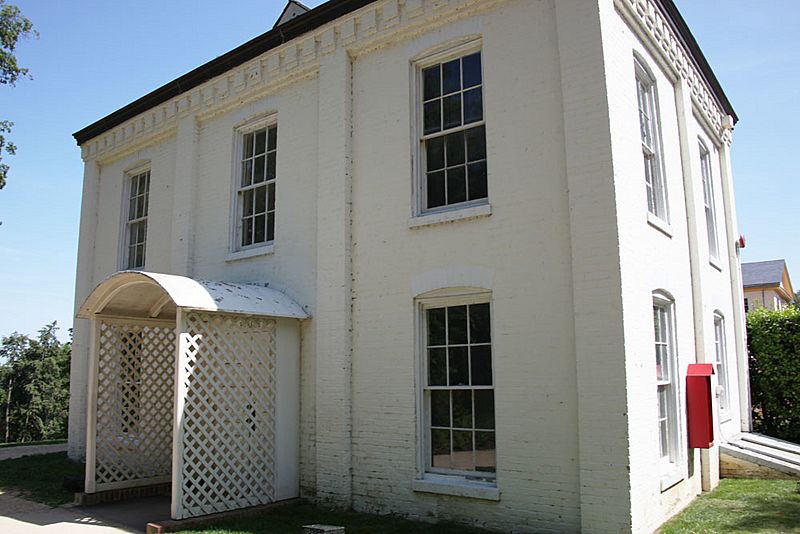Image: Potting Shed Museum - Arlington House - Arlington National Cemetery - 2012-05-19

Description: Standing at the original northern edge of the kitchen garden, looking south-southeast at the Arington House Museum (the old Potting Shed) on the grounds of Arlington House (the Robert E. Lee Memorial) at Arlington National Cemetery near Washington, D.C., in the United States. Arlington House was the first temple-form home built in the United States. Arlington House was built by George Washington Parke Custis, adopted son of George Washington, in 1803. George Hadfield, who also partially designed the United States Capitol, designed the mansion. The north wing was constructed first, and shortly thereafter the south wing began to be built. Hadfield's design for the center portion of the house meant that the facade of the north wing was rebuilt to match that of the rest of the house. The north and south wings were completed between 1802 and 1804, but the large center section and portico were not finished until 1817. There are eight Doric pillars each in the front, each pillar five feet in diameter. Each pillar is covered in plaster, and the plaster painted to look like marble. George Washington Parke Custis died in 1857, leaving the Arlington estate and house to his eldest daughter, Mary Custis Lee -- wife of General Robert E. Lee. The land on which the kitchen garden sits was originally a steep ridge, but was regraded during the construction of the house into a flat surface. G.W.P. Custis added the kitchen garden in 1840. Extending north of Arlington House for about 200 feet, the kitchen garden grew fruits and vegetables for consumption by the family and its slaves. The kitchen garden was roughly 90 feet wide, and a central path (aligned with the central path in the flower garden to the south) lined with fruit trees ran along its north-south long axis. No other trees grew in the kitchen garden, although a line of tall, mature trees (part of the native forest north of the house) screened it to the northwest and north. The kitchen garden was surrounded by a post-and-rail fence, and a gate faced with pickets and guarded on either side by barberry bushes was centered in the south side. The kitchen garden was planted primarily with vegetables, and may have included herbs (although no archeological evidence for this had been found as of 2001). In the 1880s, a potting shed (the white building here) and a greenhouse were built in the eastern half of the kitchen garden. The 110 foot-by-30 foot greenhouse had a brick foundation and glass walls. The two-story potting building was made of brick and wood, had a hipped roof decorated with dentils along the underside and ventilation cupolas on each of the hip roof's four sides. A road was built along the western and northern sides of the kitchen garden to provide access to these facilities. With the new greenhouse and potting building, the old greenhouse in the flower garden south of Arlington House was removed -- allowing for the restoration of the flower garden. The greenhouse was removed in 1930. The potting shed was converted to a museum and museum shop in the 1950s.
Title: Potting Shed Museum - Arlington House - Arlington National Cemetery - 2012-05-19
Credit: https://www.flickr.com/photos/23165290@N00/7296237700/
Author: Tim Evanson
Usage Terms: Creative Commons Attribution-Share Alike 2.0
License: CC BY-SA 2.0
License Link: https://creativecommons.org/licenses/by-sa/2.0
Attribution Required?: Yes
Image usage
The following page links to this image:

